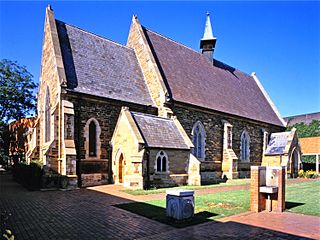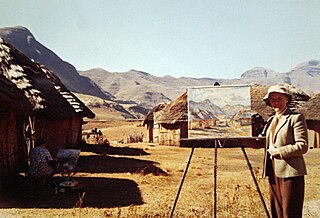
KwaZulu-Natal is a province of South Africa that was created in 1994 when the Zulu bantustan of KwaZulu and Natal Province were merged. It is located in the southeast of the country, with a long shoreline on the Indian Ocean and sharing borders with three other provinces and the countries of Mozambique, Eswatini and Lesotho. Its capital is Pietermaritzburg, and its largest city is Durban. It is the second-most populous province in South Africa, with slightly fewer residents than Gauteng.

Pietermaritzburg is the capital and second-largest city in the province of KwaZulu-Natal, South Africa. It was founded in 1838 and is currently governed by the Msunduzi Local Municipality. Its Zulu name umGungundlovu is the name used for the Umgungundlovu District Municipality. Pietermaritzburg is popularly called Maritzburg in Afrikaans, English and Zulu alike, and often informally abbreviated to PMB. It is a regionally important industrial hub, producing aluminium, timber and dairy products, as well as the main economic hub of Umgungundlovu District Municipality. The public sector is a major employer in the city due to local, district and provincial government offices located here.

The University of KwaZulu-Natal is a university with five campuses in the province of KwaZulu-Natal in South Africa. It was formed on 1 January 2004 after the merger between the University of Natal and the University of Durban-Westville.

Victoria Nonyamezelo Mxenge was a South African anti-apartheid activist; she was trained as a nurse and midwife, and later began practising law.
Ezemvelo KZN Wildlife is a governmental organisation responsible for maintaining wildlife conservation areas and biodiversity in KwaZulu-Natal Province, South Africa. Their headquarters is in Queen Elizabeth Park situated on the northern slopes of Pietermaritzburg, the KwaZulu-Natal provincial capital. Prior to 1994, it was known as the Natal Parks Board.
Pinetown is a city that forms part of the eThekwini Metropolitan Municipality, based just inland from Durban in KwaZulu-Natal, South Africa. The town is situated 16 km north-west of Durban and 64 km south-east of Pietermaritzburg.

The University of Natal was a university in the former South African province Natal which later became KwaZulu-Natal. The University of Natal no longer exists as a distinct legal entity, as it was incorporated into the University of KwaZulu-Natal on 1 January 2004. It was founded in 1910 as the Natal University College in Pietermaritzburg and expanded to include a campus in Durban in 1931. In 1947, the university opened a medical school for non-white students in Durban. The Pietermaritzburg campus was known for its agricultural engineering programmes, hence the nickname "the farmers" whilst the Durban campus was known as "the engineers," as it concentrated on other engineering programmes.
Peter McKenzie Brown was a founding member of the Liberal Party of South Africa and succeeded Alan Paton as its national chairman in 1958.

Rosa Somerville Hope, was an English painter who visited South Africa in 1935 and stayed on. Her mother was a teacher at the Camberwell School of Art and her father was recorded as an agent.
Patrick Bond is Distinguished Professor at the University of Johannesburg Department of Sociology, where he directs the Centre for Social Change. From 2020-21 he was professor at the University of the Western Cape School of Government and from 2015-19, distinguished professor of political economy at the University of the Witwatersrand Wits School of Governance. Before that, from 2004, he was senior professor at the University of KwaZulu-Natal, where he directed the Centre for Civil Society. His research interests include political economy, environment, social policy, and geopolitics.

The KwaZulu-Natal Division of the High Court of South Africa is a superior court of law with general jurisdiction over the KwaZulu-Natal province of South Africa. The main seat of the division is at Pietermaritzburg, while a subordinate local seat at Durban has concurrent jurisdiction over the coastal region of the province. As of August 2013 the Judge President of the division is Chiman Patel.
Rorke's Drift Art and Craft Centre is a center for arts and crafts, including fine art, printmaking, pottery and weaving, located in KwaZulu-Natal, South Africa. It has been described as "the most famous indigenous art centre in South Africa".

Gille de Vlieg is a photographer and anti-apartheid activist. She was born in England and moved to South Africa with her mother when she was 3 years old. During apartheid she was a member of both the Black Sash and one of the few women members of the Afrapix photography collective. Her images have been published in newspapers, magazines and books nationally and internationally. Unlike many of her counterparts, de Vlieg received little public acclaim for her work up until recently. About her work, she says, "I wanted to make a contribution to an alternative view of South Africa, a view not seen on the South African TV screen then." Her images cover the following topics: land removals, rural lifestyle, township lifestyle, gender lifestyle, United Democratic Front (UDF), anti-harassment campaign, police violence, protests against death penalty, funerals, Black Sash, protests against incorporation into Bophuthatswana; Release Mandela Campaign, End Conscription Campaign (ECC), conscientious objectors, African National Congress (ANC) Welcome Home Rally, Day of the Vow (Geloftedag), street children, and homeless people.
Patricia Joan Vinnicombe was a South African archaeologist and artist, known for identifying and copying San rock paintings in the valleys and foothills of the Drakensberg. Her work transformed the study of rock art into a science. She was also active in the preservation of Aboriginal art in Western Australia.
Allerley Glossop (1870–1955) was a South African artist known particularly for her landscape and pastoral scenes.
The following is a timeline of the history of the city of Durban in the eThekwini Metropolitan Municipality, KwaZulu-Natal province, South Africa.
The following is a timeline of the history of Pietermaritzburg. It is part of the Msunduzi Local Municipality in the Umgungundlovu District Municipality, KwaZulu-Natal province, South Africa.

Sethembile Msezane is a South African visual artist, public speaker and performer who is known for her work within fine arts. Msezane uses her interdisciplinary practice which combines photography, film, sculpture, and drawing to explore issues focused on spirituality, politics and African knowledge systems. Part of her works focus has been on the process of myth-making and its influence on constructing history as well the absence of the black female body in both narrative and physical spaces of historical commemoration. Msezanes work is held in galleries in South Africa as well as internationally and has won awards and nominations. Msezane is a member of the iQhiya Collective, a network of black women artists originating from Cape Town, Johannesburg and across South Africa.
The history of gangs in South Africa goes back to the Apartheid era.
Bongiwe or Bongi Dhlomo-Mautloa, is a Zulu South African printmaker, arts administrator and activist.








